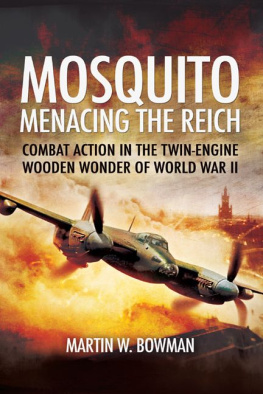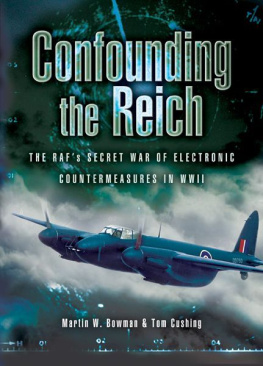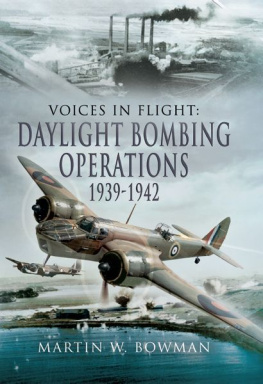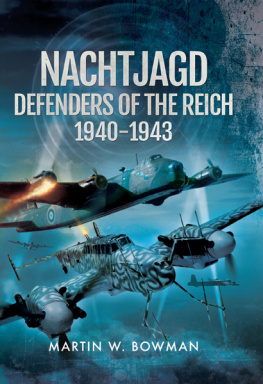
Last of the
Lancasters
Last of the
Lancasters
Martin W. Bowman

Pen & Sword
AVIATION
First Published in Great Britain in 2014 by
Pen & Sword Aviation
an imprint of
Pen & Sword Books Ltd
47 Church Street, Barnsley, South Yorkshire S70 2AS
Copyright Martin W Bowman, 2014
ISBN 9781783831746
The right of Martin W Bowman to be identified as author of this work
has been asserted by him in accordance with the Copyright,
Designs and Patents Act 1988.
A CIP catalogue record for this book is
available from the British Library.
All rights reserved. No part of this book may be reproduced or transmitted
in any form or by any means, electronic or mechanical including
photocopying, recording or by any information storage and retrieval system,
without permission from the Publisher in writing.
Typeset in 10/12pt
Palatino by GMS Enterprises
Printed and bound in England
by CPI Group (UK) Ltd, Croydon, CR0 4YY
Pen & Sword Books Ltd incorporates the Imprints of Pen & Sword
Aviation, Pen & Sword Family History, Pen & Sword Maritime, Pen & Sword
Military, Pen & Sword Discovery, Wharncliffe Local History, Wharncliffe
True Crime, Wharncliffe Transport, Pen & Sword Select, Pen & Sword
Military Classics, Leo Cooper, The Praetorian Press, Remember When,
Seaforth Publishing and Frontline Publishing.
For a complete list of Pen & Sword titles please contact
PEN & SWORD BOOKS LIMITED
47 Church Street, Barnsley, South Yorkshire, S70 2AS, England
E-mail:
Website: www.pen-and-sword.co.uk
Acknowledgements
I am indebted to all the contributors for their words and photographs. Thanks also go to my fellow author, friend and colleague, Graham Simons, for getting the book to press ready standard and for his detailed work on the photographs; to Pen & Sword and in particular, Laura Hirst; and to Jon Wilkinson, for his unique jacket design once again. Equally, I am most grateful to Sam Mealing-Mills of the Mildenhall Register for kindly allowing me to quote from his taped interview with Norman Gregory and to Nigel Clarke for putting me in touch with this fine gentleman in the first instance. Thanks also are due to Philip Swan, author of Diary of a Bomb Aimer: Training in America and Flying With 12 Squadron in WWII, for kindly allowing me to quote passages concerning Campbell Muirhead; and to my old friend and fellow author, Ian McLachlan for kindly permitting me to quote passages from the story of Harry Church in Ians book, Flights Into History which was published in 2007. Memorial Flight 2000; Journal of the Linconshire Lancaster Association; No.33 spring 2000 and No.34, autumn 2000. Special mention too must be made of the contributions made by Hugh Trevor, for his research into the activities of Major Tony Cotterell and for the photographs used in this story; 49 Squadron Association; Nigel McTeer; The Norfolk & Suffolk Aviation Museum; the Second Air Division Memorial Library, Norwich; Aeroplane and Flypast magazines and the City Of Norwich Aviation Museum.
Prologue
S. D. Clewer
My journey was the path of many airmen via 81 OTU Whitleys, then to 1662 HCU Lancasters and our posting to103 Squadron at Elsham Wolds. We arrived there in June 1943 by crew bus to book in at the Guard Room. At that moment a Queen Mary transport was leaving loaded with kit bags. I quickly realised they were missing and deceased airmens kit. A sad welcome to a great Squadron. I found myself saying out loud My kit won't go that way. Someone replied, Famous last words. The first two weeks on squadron were a complete disaster. We had four operational take offs, three of these being aborted, mainly for mechanical reasons. A mine-laying trip was no better I saw the ground twice in just over six hours flying both times - once at take off and on landing. Our skipper was carpeted for not pressing on regardless and was posted away. So there were six odd bods, one was posted to a nearby squadron. Within a month only Johnny Sheedy, flight engineer and myself remained. Johnny crewed up with Warrant Officer Kenneth Reuben Lee DFC. I flew with three crews and each time I was replaced they went missing. On one occasion my name was taken from the war order list and a Pilot Officer Deakins was substituted as he had that day returned from a Gunnery Leaders course. Fate played another card in my survival when Bob Edies rear gunner was classed as LMF. I took his place. Johnny Sheedy and I had been together for almost a year, I had a lot to thank him for. He rescued me from drowning in a dinghy drill accident. He also suffered freezing conditions when he attended to my frozen oxygen supply. He had completed 25 trips when they also failed to return, on Kassel on 22/23 October 1943. This was a shock to me as Johnny Sheedy was without doubt a brave and intelligent flight engineer. So five months and one week had elapsed when I passed the Guard Room with my kit and with my first tour completed. I have every cause to believe I was fated to survive.
Flight Lieutenant S. D. Clewer, rear gunner, 103 Squadron at Elsham Wolds, 1943.
Chapter 1
The First Daylights
It had been my ambition tonight to tell you the story of the daylight raid on Augsburg in the way it deserves to be told - to weld into words this great flying epic of all time which will rank - not merely in air history but in war history - more highly as the years go by and its glory takes on the legendary lustre of the great deeds of the past. As I sat down pen in hand, a sorry Tennyson with the story of this greater Light Brigade of the Air still dormant in the inkpot, I could see those twelve thirty-ton monsters on which they rode their charge. I had a memoried vision of trees blurring past the leading edge of a wing - of cannon shells rocketing into a little white-washed village - of the tense steely eyes of the pilot looking forward, never more than a field or two ahead - hour after hour. And then I'm sorry to say I gave it up - the brush was too shaky - the canvas too small. But I can at any rate try to re-tell you the story somehow - and retell it I will. They were called in for briefing at twelve noon on 17 April - eighty young men, mostly in their early twenties. They weren't specially picked, trained or doped with Benzedrine on the German model - they were just normally interested to find out what all the excitement was about and when they were told that they were to take on the sort of job which the Luftwaffe had given up two years ago as impossible, they seemed chiefly concerned with the contours of that last wooded hill before Augsburg over which in a few hours time some of them were to get their first glimpse of the deadly breeding ground of the submarine Diesel. Then, later in the afternoon the hunt started - a hunt for a thousand miles at fifty feet over hedges and ditches which has made every airman in the world who has ever tree-hopped for half a mile see in imagination a picture of the most fantastic chase that probably the history of pursuit has ever known - a hunt to the tally-ho of roaring engines which would have made Jorrocks turn in his grave.
Group Captain W. Helmore April 30th one of his monthly commentaries on the BBC after the 9 oclock news.
In the afternoon of 17 April 1942, a few days before the four-night attack on Rostock, a very different method was used by 5 Group, Bomber Command to attack an objective as small as, or even smaller than, the Heinkel assembly shed at Marienehe outside the town. This was the dispatch of twelve Lancaster bombers in daylight to the submarine Diesel engine assembly shed in the M.A.N. factory at Augsburg, far down in southern Germany. The Lancasters were to be back by midnight. The whole plan of this attack was worked out at Headquarters at least a week before, but the crews were told about it only on the day of the attack. They knew, however, that something was in the wind, because they had been taken off all other work and told to practise low flying in formation across country and, in particular, navigation at such a low level. When they were briefed, they were told of the great importance of the target. Half the Diesel engines for ocean-going U-boats were made in the M.A.N. factory. To reduce the supply of diesel engines would throw the whole submarine-building programme out of gear. At a time when the U-boats in the Atlantic were becoming a most serious menace it would be hard to imagine any more important single target than this assembly shed at Augsburg. It would be worth serious losses to hit this target.
Next page
















